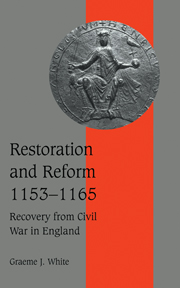Book contents
- Frontmatter
- Contents
- Preface
- List of abbreviations
- 1 The political context
- 2 The governance of England during Stephen's reign
- 3 Personnel and property
- 4 Financial recovery
- 5 The administration of justice
- 6 Conclusion
- Appendix I sheriffs' farms, 1130–65 and 1197
- Appendix II pipe roll, 11 Henry II (1164–5)
- Select bibliography
- Index
- Cambridge Studies in Medieval Life and Thought Fourth series
6 - Conclusion
Published online by Cambridge University Press: 03 September 2009
- Frontmatter
- Contents
- Preface
- List of abbreviations
- 1 The political context
- 2 The governance of England during Stephen's reign
- 3 Personnel and property
- 4 Financial recovery
- 5 The administration of justice
- 6 Conclusion
- Appendix I sheriffs' farms, 1130–65 and 1197
- Appendix II pipe roll, 11 Henry II (1164–5)
- Select bibliography
- Index
- Cambridge Studies in Medieval Life and Thought Fourth series
Summary
Henry II made many enemies during his long and turbulent reign and William of Newburgh, writing from the perspective of the 1190s, acknowledged that ‘in his own time he was hated by almost everyone’. But – like the grandfather he professed to emulate – Henry won rather more appreciation with the benefit of hindsight, and, as William of Newburgh went on to say, he ‘is now declared to have been an excellent and profitable prince’. In the political arena, he did of course accomplish a great deal. Although reverses in his last days against Philip Augustus and his own son Richard led him to die in misery and humiliation, bewailing his fate as a ‘vanquished king’, his success in assembling and sustaining an Angevin empire embracing most of the British Isles and the western half of France, in defeating rebellion on several fronts in 1173–4, and in averting a disastrous rift with the papacy following the tragic conclusion to the Becket affair were all formidable achievements. In the administrative field, his reign witnessed a transformation in the activity and availability of the king's courts in England, which bore fruit not only in enhanced revenue but also in new perceptions of the pervasiveness of royal government over most of the kingdom. But the focus of this book has been upon less dramatic events and, in relation to his government of England in the early phase of his reign, there remain three questions for further consideration here.
- Type
- Chapter
- Information
- Restoration and Reform, 1153–1165Recovery from Civil War in England, pp. 213 - 219Publisher: Cambridge University PressPrint publication year: 2000



